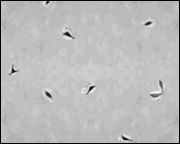What is cell growth? The term cell growth can either mean a change in the size of a cell or a change in the number of cells. two different interpretations in biology. When used in the context of reproduction of living cells the phrase "cell growth" conveys the idea of "increase in the cell count by means of cell reproduction." During cell reproduction one cell divides to become to progeny (daughter) cells. In other contexts, cell growth refers to the size of a cell. The term cell growth in VC is used in the sense of the increase in the number of cells. Cell Size Many cells never have a large increase in size after they are first formed from a parental cell. Typically cells reproduce, double in size, then reproduce again. This implies that for a given type of cells, a constant cell density can be defined. The protein mTOR is a serine/threonine kinase that regulates translation and cell division. Nutrient availability influences mTOR so that when cells are not able to grow to normal size they will not undergo cell division. The details of the molecular mechanisms of mammalian cell size control are currently being investigated. Physical limits of cell growth The reproduction of cells, or the cell proliferation stops when the space available for the cell growth becomes limiting, or when confluence is reached (See the animation below. Courtesy: http://www.bme.gatech.edu/vcl/Tissue_Engineering/Background/5_cell_seeding.htm) 
Owing to this reason, the specification of the volume of a cell culture and the maximum (limiting) cell density defines a specific maximum number of cells that the cell culture can proliferate to. Cell growth modeling parameters in VC The input parameters for setting up the cell kinetics model can be thought to consist of two different classes of inputs specified right to the keyword CCKM: Cell biological parameters (TCC, TPOT, GF and KAP) and the physical parameters describing the cell culture or the tissue (N0 and VOL). The following tutorials illustrates the use of these two classes of input parameters with the help of the RMR model
CCKM: Specifying the parameters used for modeling cell growth.
Use of the TCC, TPOT and GF parameters (Tutorial #12)- Example 12.1 The effects of TCC, the cell birth rate and TPOT, the Potential Doubling Time.
- Example 12.2 The effect of GF, the growth fraction.
Use of the KAP and VOL parameters (Tutorial #13)- Example 13.1 The effects of KAP, the peak cell density and VOL, the culture or tissue volume of interest.
| 
